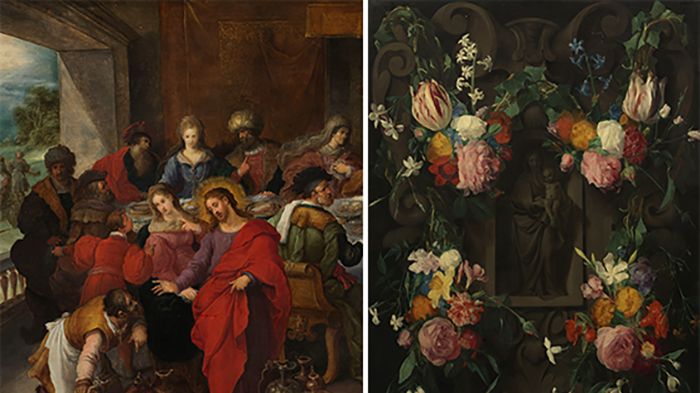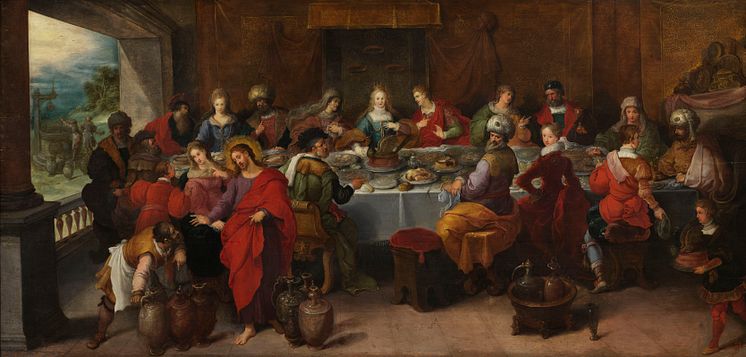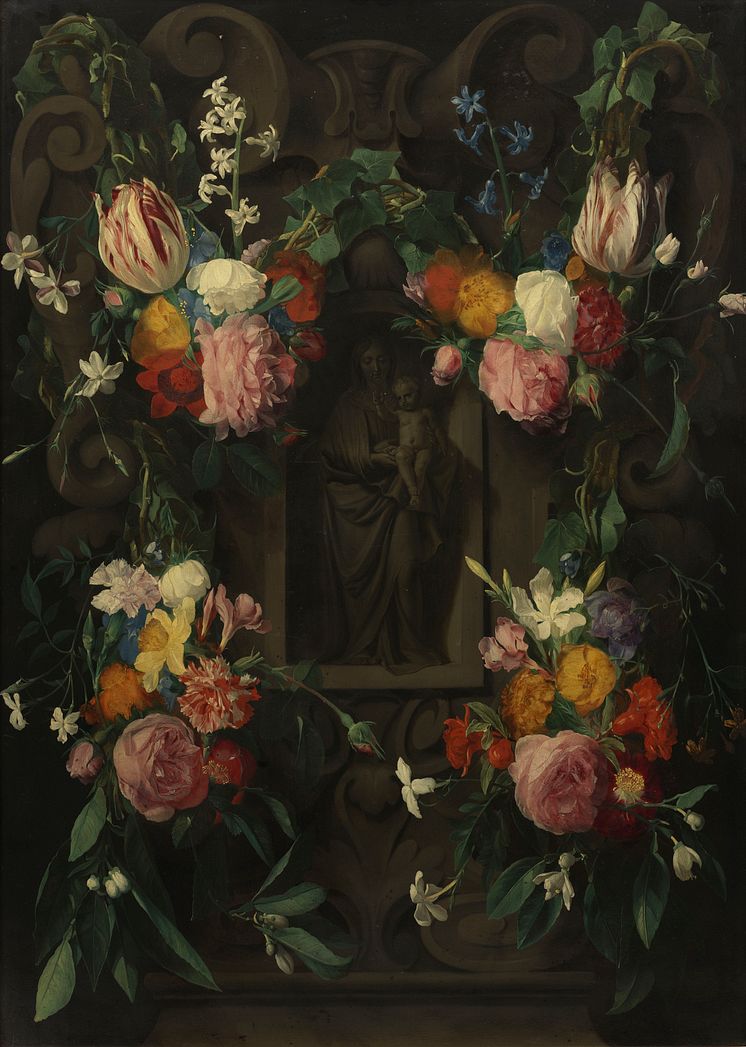
Press release -
Nationalmuseum acquires two Flemish masterpieces
Nationalmuseum has acquired two important oil paintings by Frans Francken the Younger and Daniel Seghers, both influential artists in 17th-century Antwerp, the Golden Age of Flemish art. Before now the Nationalmuseum did not own any painting by Francken of this significance. And by acquiring Seghers’ large-format painting on copper, the museum is now better able to reflect the earliest period of art collecting in Sweden.
Frans Francken the Younger (1581-1642) belonged to a large, well-known family of artists whose members were active in Antwerp for several generations. They specialised in typically richly coloured, small-figure cabinet paintings. The Wedding at Cana of circa 1618/20, depicts the story from the Gospels of St. John about the miracle that occurred at the wedding in Cana, a popular motif in the Francken studio. The bride and groom are shown seated among the wedding guests under a canopy at the centre of the composition. In the left foreground, Christ, wearing a bright red robe, is seen turning water into wine, surrounded by wine jugs. On the empty stool opposite the bridal couple, vacated by Christ, the artist has signed his name. The painting’s rich detail, and the figures dressed in colourful “oriental” garb, are typical of Flemish cabinet painting. The painting comes from the collections of The State Hermitage Museum in St Petersburg, parts of which were deaccessioned by the Soviet authorities in the late 1920s. It was subsequently acquired by Swedish ambassador Vilhelm Assarsson (1889-1994). Through his bequest the painting then became part of the art collection owned by the Swedish Academy, from whence it was sold to the Nationalmuseum.
Daniel Seghers (1590-1642) was a student of Jan Brueghel the Elder. In 1625 he was ordained as a priest in the Jesuit Order. At an early age, Seghers specialised in still life paintings with floral cartouches and religious motifs. Flower Garland with the Virgin and Child of circa 1645-50 was painted on an unusually large-format copper plate. In an arched niche at the centre of the composition is an image of the Virgin and Child in the form of a stone sculpture painted in trompe-l’oeil. The surrounding cartouche in grisaille is decorated with garlands of flowers, some of which symbolise the virtues of the Virgin. The central image of the Virgin was probably executed by Erasmus II Quellinus (1607-1678), one of the artists with whom Seghers collaborated over the years. Together they produced around 29 compositions comparable to the present example, one of which bears the signatures of both artists. A majority of these works were not intended for sale but were instead used by the Jesuit Order as diplomatic gifts to European rulers and other prominent persons. The painting belonged to the well-known art collection at Österbybruk in Uppland, and thus has an early Swedish provenance. There, it was one of the most highly valued paintings in the art collection of Henrik Wilhelm Peill (1730-1797) and his spouse Anna Johanna Grill (1745-1801).
“We are very pleased, indeed, with these two acquisitions, which complement the museum’s holdings of European Baroque art in a most satisfactory manner. Francken’s painting is a cabinet painting of unusually large size. It is a fine example of Flemish cabinet painting as a genre, which will eventually find its place in the chronological and thematic presentations of the museum’s collections. In addition to its exceptional quality as a work of art, Seghers’ painting may also yield valuable information on the techniques of oil painting on copper, as well as the early history of collecting in Sweden", says Carina Fryklund, curator old master drawings and paintings at Nationalmuseum.
Nationalmuseum receives no state funding with which to acquire design, applied art and artworks, instead the collections are enriched through donations and gifts from private foundations and funds. The acquisition was made possible through contributions from the Sara and Emil Graumann foundation and the Wiros foundation.
Inventory number:
Frans Francken the Younger., The Wedding at Cana, ca 1618–20, NM 7504.
Daniel Seghers, Flower Garland with the Virgin and Child, ca 1645–50, NM 7505.
For more information
Carina Fryklund, curator, carina.fryklund@nationalmuseum.se, +46 (0)8 5195 4475
Hanna Tottmar, press officer, press@nationalmuseum.se, +46 (0)8 5195 4400
Categories
Nationalmuseum is Sweden’s museum of art and design. The collections comprise older paintings, sculpture, drawings and graphic art, and applied art and design up to the present day. The museum building has currently been renovated and reopened in autumn 2018. Nationalmuseum has partnerships with Svenska Dagbladet, Bank of America Merrill Lynch, The Wineagency and the Grand Hôtel Stockholm.



